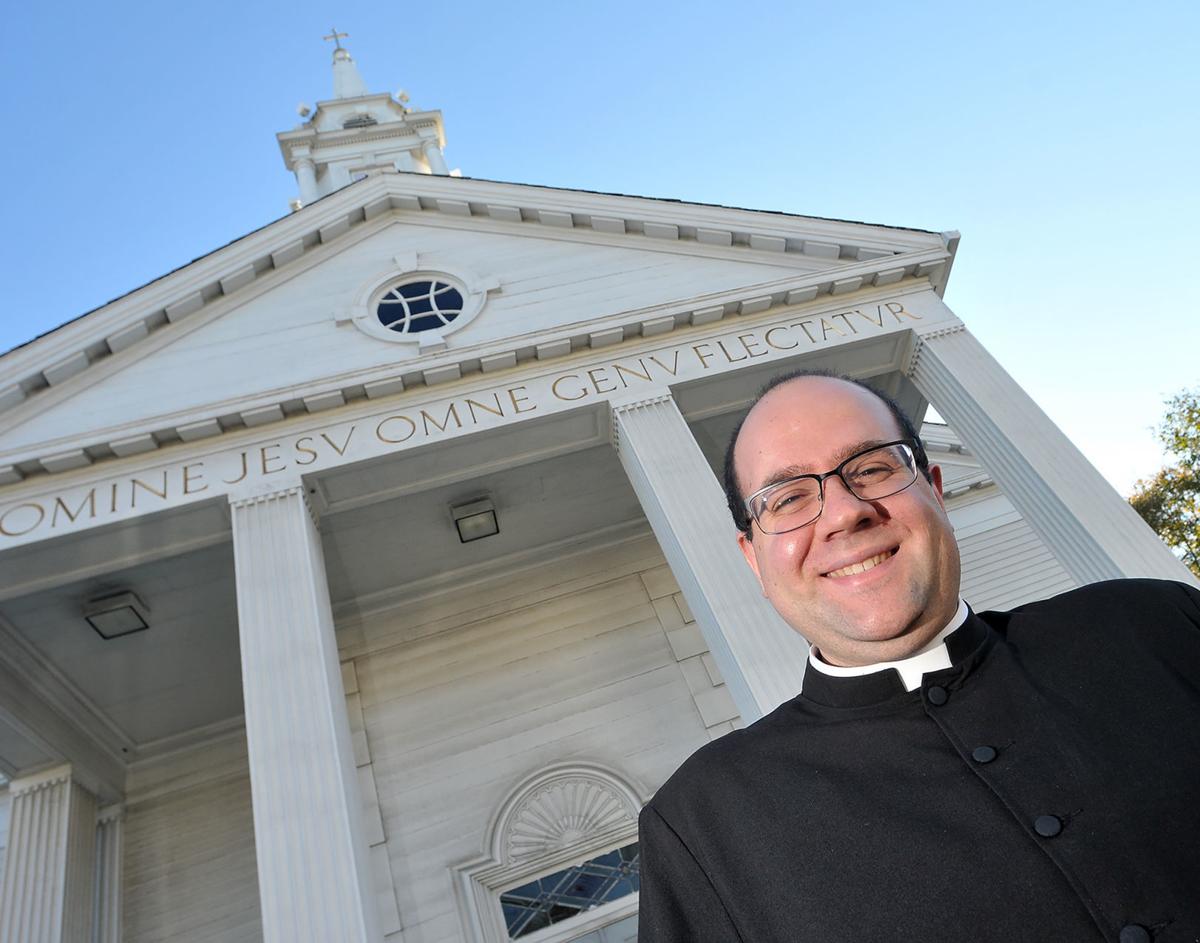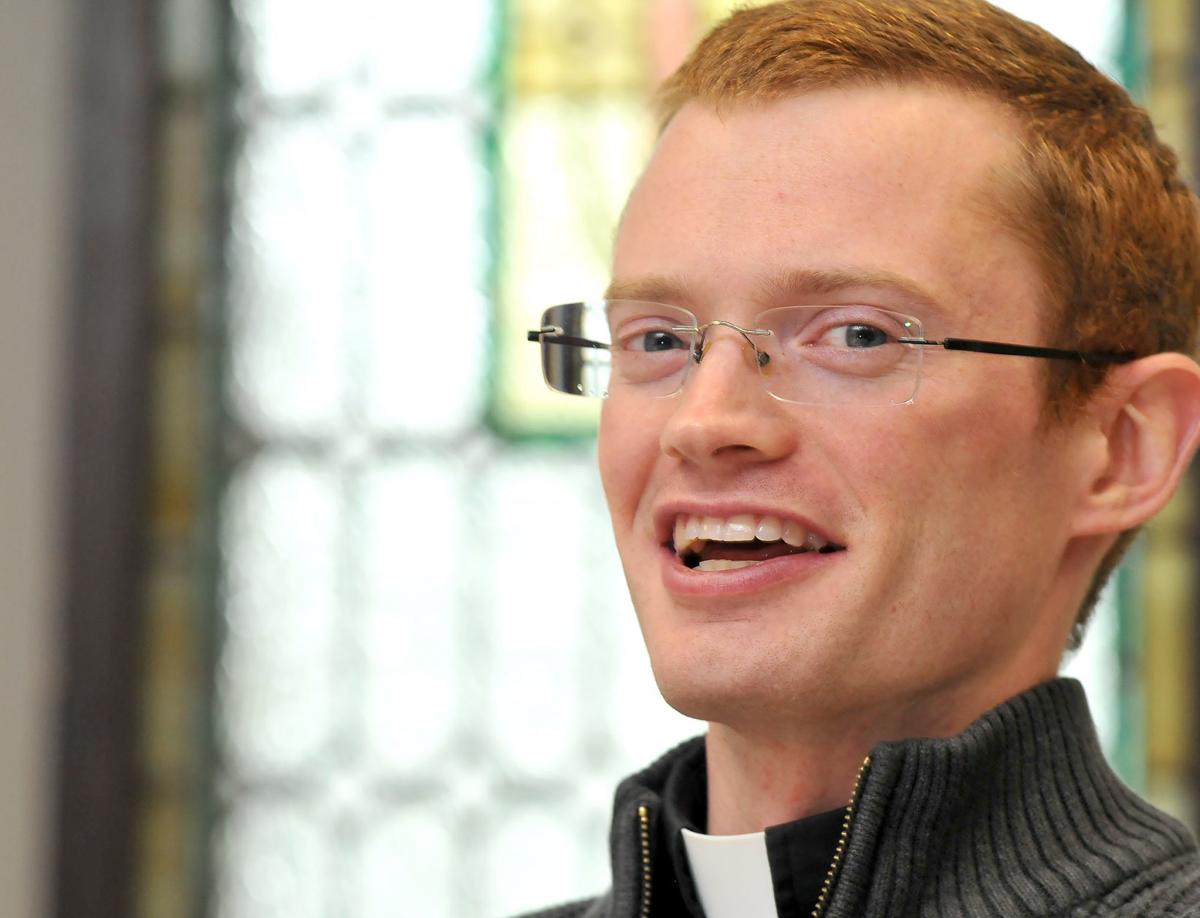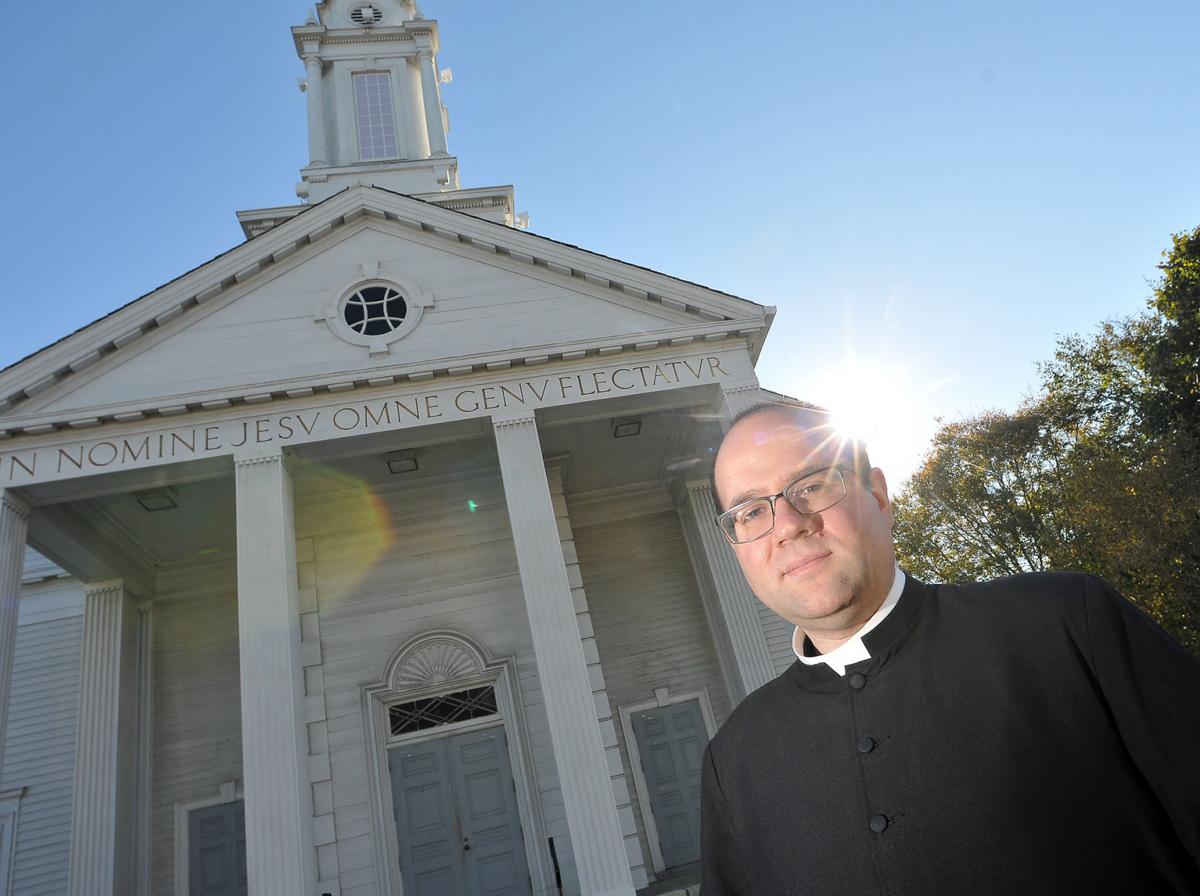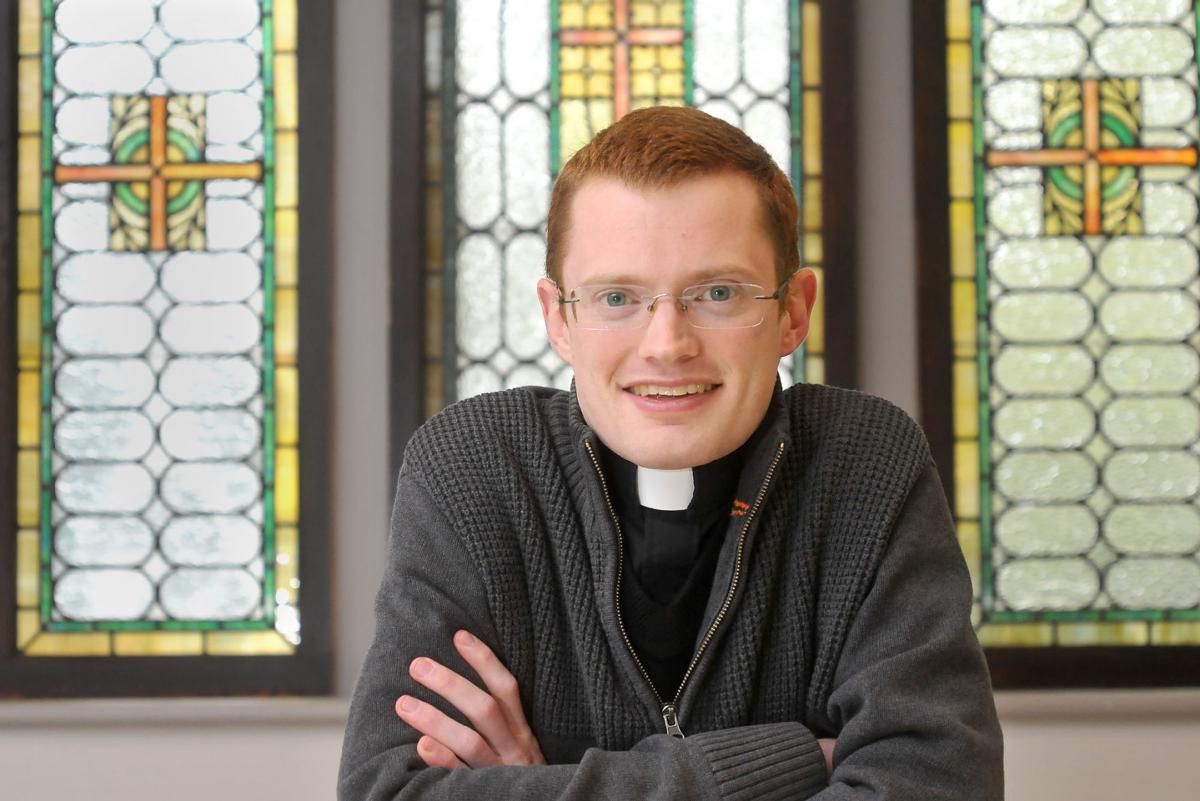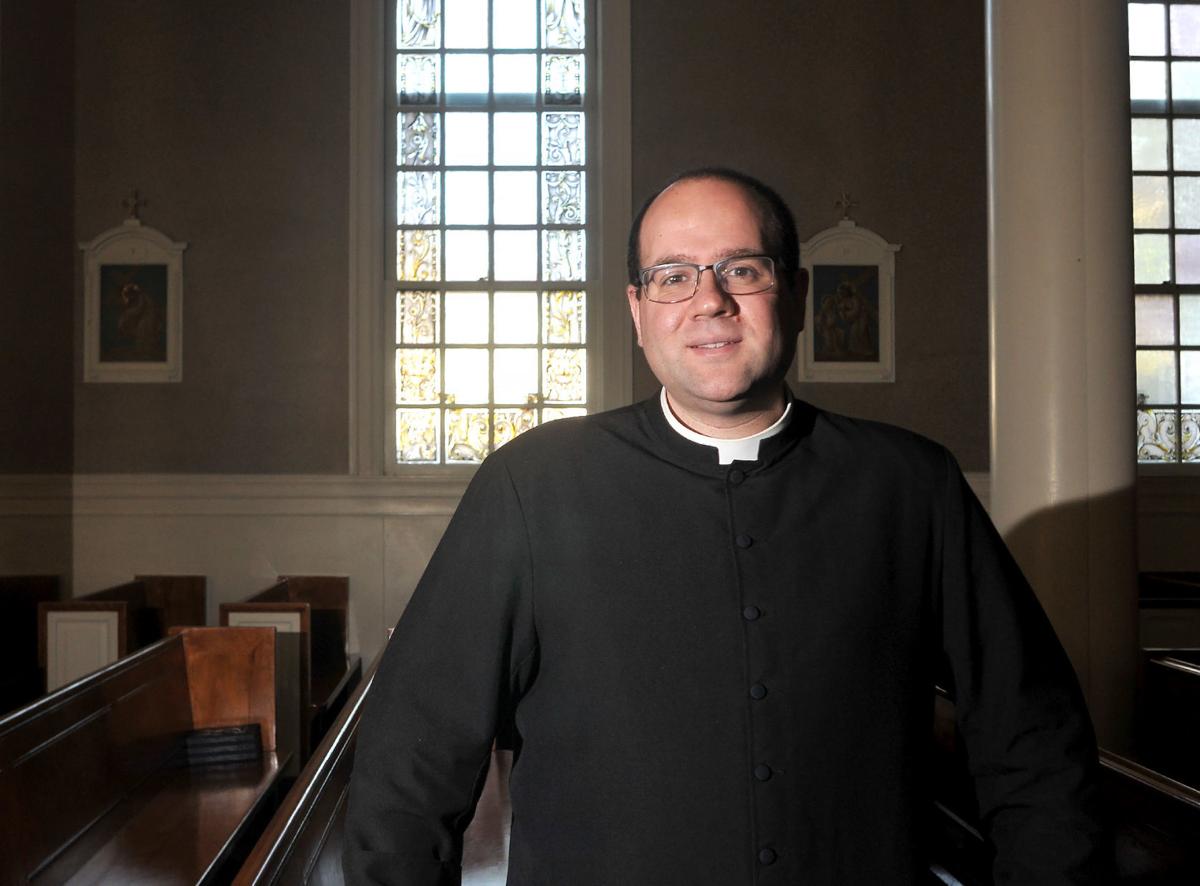Called to Serve: Despite Challenges Facing the Catholic Church, Two Local Priests Say They Couldn’t Ignore Their Vocation
By Mark Stockwell
Matthew Gill was born into a devout Catholic family in January 1990. It was the dawn of a new life, a new decade and the eve of a very dark time for the faith held by his devout family. Nineteen-ninety was another in a long string of years that marked a continuing decline in church attendance. And the number of men entering the priesthood had fallen off sharply. Ironically, however, it was the year that recorded the greatest number of parishes nationwide, before or after. That number was 19,620, according to statistics compiled by the Center for Applied Research in the Apostolate (CARA) at Georgetown University. There were 34,114 diocesan priests to serve those parishes, in purely mathematical terms, 1.7 priests per parish. In 1970 there were slightly more than two priests per parish, again in purely mathematical terms, 2.05. So in 1990 some parishes went without, 1,812, or 9 percent, to be exact. That was a trend that started long before. Even in 1970, there weren’t enough parish priests; 571 parishes across the nation went without. That was a time of fewer parishes, 18,224, and more diocesan priests, 37,272. So in 1990 the number of parishes had peaked and the number of parish priests was falling fast. There was an 8 percent loss, 3,158 priests, in 20 years. To make matters worse, the faithful were falling off as well. By the time Gill turned 5 and was ready for preschool in 1995, only 50 percent of those who identified themselves as Catholics said they had attended church in the previous seven days, according to a Gallup poll. That percentage was down from 54 percent in 1975, 67 percent in 1965 and 75 percent in 1955. Today that number is 39 percent, according to a Gallup poll published in April. But there was more than a growing indifference to the church. Gill was born on the eve of what has become the worst sex abuse scandal of modern times, and it came from his church. When Gill was 3 years old in October of 1993, James R. Porter, a former priest who served at St. Mary’s Church in North Attleboro in the 1960s, was sentenced to 18-20 years in a maximum security prison after pleading guilty to sexually assaulting 28 children in Southeastern Massachusetts. If born a generation earlier, Gill could have been one of those innocents who were violated in ways they barely understood, but knew to be evil and wrong. The young victims of powerful and supposedly holy men were left in a torturous, silent maelstrom of shame, guilt, confusion and emotional pain that scarred them for life. But fortunately, Gill was born in a later time, a time in which it was less likely a child would be a priest’s victim. He was spared the terror. And later, in 2002, when Gill was 12, The Boston Globe broke the stone cold silence of the church and revealed its polluted proselytizing with stories about the serial rapes by pedophile priest John Geoghan in the Archdiocese of Boston. Geoghan was accused of having sexually molested at least 130 children. To make matters even worse, his crimes were covered up by superiors including the late Cardinal Bernard Law, who transferred Geoghan to new parishes with no warning that he was a dangerous man. Eventually, Geoghan was convicted of one assault and sentenced to prison, where he was murdered by a fellow inmate. At the time, Gill was a student at St. John the Evangelist School on Hodges Street in Attleboro and was aware, at the outer edges of his 12-year-old consciousness, that something was going on in a faith he was learning to love at his school and at St. John the Evangelist Church. But at 12, he was too young to comprehend a crime so immense that even today, world-wise adults have trouble doing so. He was a child and was concerned with childhood things. “When that story broke, I was worried about getting my homework done,” he said. “I was in the sixth grade, it wasn’t on my radar.” Besides his studies, Gill was involved in sports like soccer and baseball. He loved the outdoors and flourished as a member of the Boy Scouts, attaining its highest rank, Eagle Scout. After graduation in 2008 from Bishop Feehan High School, then in the early stages of adulthood, he attended McDaniel College in Maryland where he could study his two passions, music and environmental science. Gill’s intent was to land a career in which he would not be office-bound, such as a musician, where the stage was his office, or an environmental scientist, where his work would take him outdoors. “I loved playing music and listening to music,” he said in a interview this week at the church in which he grew up. “I wanted to learn about music theory and I wanted to be outside and not confined to an office.” XXX Those passions remain today, but his life took a different path in a time when the church was challenged not just by a declining participation of the faithful but by the sex scandals that have scarred the church deeply from top to bottom and devastated the lives of thousands of victims. The depth and breadth of the sexual abuse scandal was profound. Its horror has touched every state in America and many countries around the world. In the U.S. there are an estimated 19,361 victims, as computed in the combined calculations of two studies. One, by John Jay College of Criminal Justice in New York, produced figures through 2004. The second was by CARA, which added numbers from 2004 to the present. According to their studies, about 4 percent of priests in the Catholic church were responsible for the massive carnage of young souls. The number reported by the JJCCJ study was 4,392 priests. Both studies show that those acts of betrayal and violence are mostly in the past; they peaked in the 1970s and gradually declined thereafter. The CARA study put the number of reports of past or current abuse since 2004 at 8,694. The greatest percentage, 31, occurred in the 1970s, when there were 2,710 cases. Most of the priests committing the atrocities were ordained from approximated 1960 to 1979 and were born in the 1930s through the 1940s, according to the studies. Some were even born much earlier; a few in the 19th century. The number of cases fell to 346 in the 1990s, when news of abuse was final reaching the public, such as in the case of Porter. But as the anonymous author of a recent CARA blog post concerning the subject put it, no number except zero is acceptable. “New abuse allegations have not disappeared. In the last three years, 22 allegations of abuse occurring during 2015-2017 have been made,” said the author of the article “Pain Never Disappears from Unhealed Wounds.” “This is an average of about seven per year nationwide in the Church. That is far too many. Nothing is acceptable other than zero.” Priests who committed the majority of the crimes were aging, retiring or dying during the 1990s and into the new century. And in 2002 the U.S Conference of Catholic Bishops adopted the Charter for the Protection of Children and Young People, informally known as the “Dallas Charter,” which set new standards for the priesthood and set up safeguards against abuse and ways to deal with it. The JJCCJ study established that 81 percent of the victims were male and 51 percent of those victims were between the ages of 11 and 14, boys often active in the church, altar boys or youth group participants. They were much like Gill, who at that age was learning about his faith, growing in it and believing in the goodness of the church. XXX Fortunately, Gill was spared. But not only that, he was called, called to be a priest. During college, Gill liked to run for recreation and sometimes during those runs he thought of dedicating his life to God instead of music, the environment or some combination of the two. It was a paradigm shift for him and it was something way beyond a simple earthly desire, he said. “When I was on my runs the thought of priesthood entered into my mind,” he said. “When I was in my sophomore year it kept entering into my mind and I couldn’t put it out of my mind.”
It was a call coming from, in his words, his lord and savior, Jesus Christ. It was a call not to be ignored, although he admits he tried. As he had been throughout his life, he was active in his faith during college and that included a trip to a conference concerning the Catholic faith. Part of the conference included efforts to interest young men in the religious life as a calling. Booths were set up. Pamphlets were available as were members of the life to talk about it. “When I went through that area, I kept my eyes glued to the ground,” Gill said. “I did not want to make eye contact. But on the last day someone yelled at me and I said, ‘Oh man, I’m going to have to talk to him.’ ” That reluctant conversation changed the course of Gill’s life. The gentleman who called out was one who had become a priest after seeking another life. He quit his job as, of all things, an environmental engineer, a pursuit Gill was contemplating, because his life was unfulfilling. For Gill, that was not just some guy talking to him. It was Jesus talking through this man. “I knew at that moment I couldn’t run away from it any longer,” Gill said. For Gill, entering seminary was not a reaction in any way to the dire state of the church in regard to its loss of the faithful or the sexual abuse crisis. It was simply the call from Jesus Christ to serve, he said. “Going into seminary, you know it’s out there,” he said of the sexual abuse crisis. “You know that awful and terrible things had happened. But it didn’t weigh on my decision. It was Christ’s call. It wasn’t up to me. If it was up to me, I’d be playing in a jazz band right now.” XXX But becoming a priest is not like joining the Army. It’s a long, thoughtful and prayerful process by both the aspirant and the church. In Gill’s case it was a six-year process from the time he attended seminary until ordination. Not all seminarians make it through. Some discover the religious life is not for them. And sometimes the church itself says that it’s not for them. Some leave for a time and then return when they and their mentors decide they’re ready.
That was the case for Father Daniel Nunes, 35, a Swansea native who’s the assistant pastor at Holy Name Church in Fall River. Ordained last June, he spent 10 years becoming a priest. He went into seminary connected to Providence College right out of Bishop Connelly High School in Fall River, but after a while, it was decided it was not yet his time. “I needed to work in the real world,” Nunes said. He spent three years working as a supervisor for a health care company. Day-to-day interactions in the work-a-day world full of business problems and people problems gave him the worldly experience he lacked. “It got me ready,” he said. XXX Father Kevin Cook is the vocation director for the Diocese of Fall River and the pastor at Our Lady of Mount Carmel in Seekonk. Becoming a priest can take eight years if entering from high school or even longer, if for example the church determines that an individual, like Nunes, needs more experience in the outside world. There are four main aspects of what is known as “priestly formation,” he said — academic, spiritual, human and pastoral. Academic study is focused on philosophy, religion and counseling. Spiritual formation focuses on the development of a “prayful” life and how to emulate, as best one can, Jesus. Human formation focuses on the development of character and virtue and how to listen well, for example. And pastoral formation involves learning how to guide people suffering from serious illness or those who have committed crimes or those who are dealing with death. And there are teachings on sexual abuse, Cook said “They all go through training on appropriate boundaries and understanding sexual abuse,” he said in an email. “They receive a training on what they must do if they have anyone come to them about having been abused (all priests are mandatory reporters), not only legally, but also how to listen to the person who is saying they have experienced abuse.” Aspiring priests also learn “how to prudently meet with individuals or youth in public areas and proper times so it can help lessen opportunities for an individual to make a false accusation and one has no way to defend oneself.” Gill said his training included extensive work on the issue of sexual abuse that included training about interactions with minors. “There are procedures in place to ensure the safety of everybody, including the priest,” he said. XXX The process of becoming a priest is one of evolution. In some ways the path is laid out, but not all are ready to make the trip, Cook said. “Some can go with the natural flow,” he said. “Others need more time. Some may need a better understanding of what people do in the real world.” Aspiring priests need to “really listen in a busy life if God is really calling you.” And not all seminarians know they want to pursue the priesthood when they are 18 or 22 or even 32, Cook said. Of the 14 seminarians currently studying to be priests in the Diocese of Fall River, two are in their 50s and another is in his 40s, he said. “Having someone in their 40s or 50s is not unusual, but it’s not the average age, which is in the upper 20s or early 30s,” Cook said. And while he thinks the sexual abuse crisis has impacted the desire of some to become priests, for those who are truly called, the call is something that can’t be resisted. “It’s really something deep in their heart,” Cook said. “It’s something they can’t shake. There’s something peaceful about it. It’s a path they should take.” According to statistics from CARA, the number of seminarians has declined along with the numbers of priests. In the last 50 years, the number of seminarians peaked in 1970 with 6,602. It reached its lowest point in 1995 when there were less than half, or 3,172. Since that time the number more or less leveled of fluctuated between 1995’s number of 3,172 and 3,650 in 2015. The number in 2017 was 3,405. Cook said the current seminarian census for the Fall River Diocese is “the most we’ve had in a while” but seems to have leveled off. “We’re not where we need to be yet, but we’re getting better,” he said. XXX
Meanwhile, Gill is now Father Gill, or as some call him Father Matt. He attended St. John’s Seminary in Boston for six years and was ordained in June along with two others, including Nunes, and is an assistant pastor at Our Lady of Victory Church in Centerville and Our Lady of the Assumption in Osterville, both villages in the town of Barnstable. And while he was never impacted personally by the sexual abuse crisis and did not make it a factor in following his calling, it reared its ugly head just months after his ordination. That’s when a grand jury’s report in Pennsylvania was released, accusing 300 priests of abusing at least 1,000 victims. Most of the allegations are not new and conform to a timeline similar to other abuse allegations, with much of the incidents happening decades ago by priests now retired or dead. And there was the resignation of Cardinal Theodore McCarrick, 88, the former archbishop of Washington, D.C. after allegations he sexually abused minors and adult seminarians. McCarrick denies the allegations. The archbishop of Washington, D.C., Donald Wuerl, also resigned after accusations he covered up sexual abuse scandals while he was the bishop of Pittsburgh. The sexual abuse scandal is an issue that does not go away but is one that Gill and every other priest must address, and he said he will do that. The acts of evil men are not the acts of God. “I remind people that Christ is with his church and though it seems that it’s a very dark period, even in this dark period the Lord wants to raise up saints,” he said. “The Lord is not going to abandon his church.” There is faith, hope and joy in the church, Gill said. Priests must be held to the highest standards. “There should be a high expectation of holiness for priests,” he said. Nunes, like Gill, was born into a devout Catholic family. He said the process he followed to become a priest was similar to Gill’s except that it took a little longer.
“I wanted to be a priest since high school,” he said. “But it’s a gradual thing. It takes years to realize that Jesus Christ is really calling you to follow him.” Like Gill, Nunes said the sexual abuse scandal did not impact his recognition of a calling to become a priest. But it needs to be handled head on, he added. He was only a priest two months when he addressed it in a homily calling the perpetrators evil men. And he called out those who would continue to hide the ugly truth. “Unfortunately the cover-up has continued,” Nunes said, referring to the resignation of the cardinals. The Dallas Charter, which has often been criticized for not holding bishops and higher-ups to account, needs revision, he indicated. “Now it’s about making bishops responsible for their role,” Nunes said. He echoed Gill’s pronouncement that priests must be above reproach. “We should be held to greater account,” Nunes said.
|
.
Any original material on these pages is copyright © BishopAccountability.org 2004. Reproduce freely with attribution.
